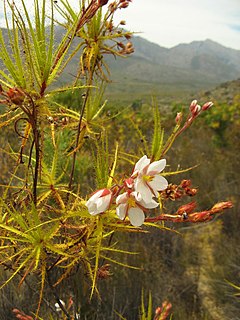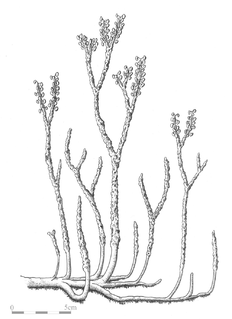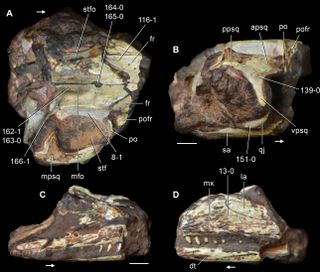| Caytonanthus Temporal range: | |
|---|---|
| Scientific classification | |
| Kingdom: | Plantae |
| Clade: | Tracheophytes |
| Division: | † Pteridospermatophyta |
| Order: | † Caytoniales |
| Genus: | † Caytonanthus Harris 1937 |
| Species | |
Caytonanthus is an extinct genus of seed ferns.
| Caytonanthus Temporal range: | |
|---|---|
| Scientific classification | |
| Kingdom: | Plantae |
| Clade: | Tracheophytes |
| Division: | † Pteridospermatophyta |
| Order: | † Caytoniales |
| Genus: | † Caytonanthus Harris 1937 |
| Species | |
Caytonanthus is an extinct genus of seed ferns.
Caytonanthus is the polliniferous organ-genus of the Caytoniales, and it is often found along Sagenopteris and Caytonia . Caytonanthus remains have been found in Greenland, UK, Hungary Russia, Poland, India, Antarctica and Argentina. [1] Caytonanthus has simple or multiple orders of branches arrayed along axes, each terminal branch bears one or many synangia, each composed by four, partially fused, pollen sacs. [1]

Roridula is a genus of evergreen, insect-trapping shrubs, with two species, of about 1⅓–2 m. It is the only genus in the family Roridulaceae. It has thin, woody, shyly branching, upright, initially brown, later grey stems, with lance- to awl-shaped leaves crowded at their tips. The star-symmetrical flowers consist from the outside in of five, green or reddish, free sepals, alternating with five white, pink or purple, free petals. Further to the middle and opposite the sepals are five stamens with the anthers initially kinked down. These suddenly flip up if the nectar-containing swelling at its base is being touched. The center of the flower is occupied by a superior ovary. The leaves and sepals carry many sticky tentacles of different sizes, that trap insects. Roridula does not break down the insect proteins, but bugs of the genus Pameridea prey on the trapped insects. These later deposit their feces on the leaves, which take up nutrients from the droppings. The species can be found in the Western Cape province of South Africa. They are commonly known as dewstick or fly bush in English and vlieëbos or vlieëbossie in Afrikaans.

Eudimorphodon was a pterosaur that was discovered in 1973 by Mario Pandolfi in the town of Cene, Italy and described the same year by Rocco Zambelli. The nearly complete skeleton was retrieved from shale deposited during the Late Triassic, making Eudimorphodon one of the oldest pterosaurs known. It had a wingspan of about 100 centimeters (3.3 ft) and at the end of its long bony tail may have been a diamond-shaped flap like in the later Rhamphorhynchus. If so, the flap may have helped it steer while maneuvering in the air. Eudimorphodon is known from several skeletons, including juvenile specimens.

Hibbertia, commonly known as guinea flowers, is a genus of flowering plants in the family Dilleniaceae. They are usually shrubs with simple leaves and usually yellow flowers with five sepals and five petals. There are about 400 species, most of which occur in Australia but a few species occur in New Guinea, New Caledonia, Fiji and Madagascar.

Alioramus is a genus of tyrannosaurid theropod dinosaurs from the Late Cretaceous period of Asia. It currently contains two species. The type species, A. remotus is known from a partial skull and three foot bones recovered from the Mongolian Nemegt Formation, which was deposited in a humid floodplain about 70 million years ago. These remains were named and described by Soviet paleontologist Sergei Kurzanov in 1976. A second species, A. altai, known from a much more complete skeleton also from the Nemegt Formation, was named and described by Stephen L. Brusatte and colleagues in 2009. Its relationships to other tyrannosaurid genera were at first unclear, with some evidence supporting a hypothesis that Alioramus was closely related to the contemporary species Tarbosaurus bataar. However, the discovery of Qianzhousaurus indicates that it belongs to a distinct branch of tyrannosaurs, namely the tribe Alioramini.

Calyceraceae is a plant family in the order Asterales. The natural distribution of the about sixty species belonging to this family is restricted to the southern half of South America. The species of the family resemble both the family Asteraceae and the Dipsacaceae.
The Southbridge Branch was a branch line railway that formed part of New Zealand's national rail network. It was located in the Canterbury region of the South Island and operated from 1875 until 1967. Five kilometres of the line remains open as the Hornby Branch, formerly the Hornby Industrial Line.

Notharctinae is an extinct subfamily of primates that were common in North America during the early and middle Eocene. The six genera that make up the group contain species that are among the most primitive of the adapiform group, which is one of the most primitive groups of primates. The evolutionary history of this subfamily has been comparatively well documented and has been used to argue for evolutionary gradualism. Though it is generally accepted that adapiforms gave rise to modern day lemurs and lorises, it is not currently known which branch of Adapiformes these living species are most closely related to. Notharctines became extinct in the middle Eocene, most likely because of a combination of factors including climatic change and competition with other North American primates.
Barcella is a monotypic genus of flowering plant in the palm family found in the States of Amazonas and Roraima in northwestern Brazil. The only known species is Barcella odora which is used by the Brazilian peoples in construction and for various thatched goods.

Uranocentrodon is an extinct genus of the family Rhinesuchidae. Known from a 50 centimetres (20 in) skull, Uranocentrodon was a large predator with a length up to 3.75 metres (12.3 ft). Originally named Myriodon by van Hoepen in 1911, it was transferred to a new genus on account of the name being preoccupied in 1917. It has been synonymized with Rhinesuchus, but this has not been widely supported. It was also originally considered to be of Triassic age, but more recent analysis has placed its age as just below the Permian-Triassic boundary.

The Caytoniales are an extinct order of seed plants known from fossils collected throughout the Mesozoic Era, around 252 to 66 million years ago. They are regarded as seed ferns because they are seed-bearing plants with fern-like leaves. Although at one time considered angiosperms because of their berry-like cupules, that hypothesis was later disproven. Nevertheless, some authorities consider them likely ancestors or close relatives of angiosperms. The origin of angiosperms remains unclear, and they cannot be linked with any known seed plants groups with certainty.

Caytonia is an extinct genus of seed ferns.

Sagenopteris is a genus of extinct seed ferns from the Triassic to late Early Cretaceous.
Arganasuchus is an extinct genus of "rauisuchian" (loricatan) archosaur. It is known from a single species, Arganasuchus dutuiti. Fossils of this genus have been found in Upper Triassic rocks of the Argana Basin, Morocco. Though its remains were initially referred to Ticinosuchus when discovered during the 1970s, in 2007 it was identified as a distinct genus with unique features of the pubis and maxilla. Arganasuchus also had several anatomical details in common with Batrachotomus, Fasolasuchus, and Postosuchus, though its relations with other loricatans remains unresolved. Arganasuchus is considered a carnivore due to its large, knife-shaped teeth.

Vancleavea is a genus of extinct, armoured, non-archosaurian archosauriforms from the Late Triassic of western North America. The type and only known species is V. campi, named by Robert Long & Phillip A Murry in 1995. At that time, the genus was only known from fragmentary bones including osteoderms and vertebrae. However, since then many more fossils have been found, including a pair of nearly complete skeletons discovered in 2002. These finds have shown that members of the genus were bizarre semiaquatic reptiles. Vancleavea individuals had short snouts with large, fang-like teeth, and long bodies with small limbs. They were completely covered with bony plates known as osteoderms, which came in several different varieties distributed around the body. Phylogenetic analyses by professional paleontologists have shown that Vancleavea was an archosauriform, part of the lineage of reptiles that would lead to archosaurs such as dinosaurs and crocodilians. Vancleavea lacks certain traits which are present in most other archosauriforms, most notably the antorbital, mandibular and supratemporal fenestrae, which are weight-saving holes in the skulls of other taxa. However, other features clearly support its archosauriform identity, including a lack of intercentra, the presence of osteoderms, an ossified laterosphenoid, and several adaptations of the femur and ankle bones. In 2016, a new genus of archosauriform, Litorosuchus, was described. This genus resembled both Vancleavea and more typical archosauriforms in different respects, allowing Litorosuchus to act as a transitional fossil linking Vancleavea to less aberrant archosauriforms.
Tsylmosuchus is an extinct genus of potentially dubious ctenosauriscid archosauriform reptile known from Western Russia. Fossils referred to Tsylmosuchus occurred over a wide area in sediments corresponding to the Induan and Olenekian stages of the Early Triassic. Most of these fossils are fragmentary neck vertebrae which were originally reported as sharing similarities with crocodile-line archosaurs (pseudosuchians) such as Mandasuchus. As a result, Tsylmosuchus was first described as part of the family Rauisuchidae, making it supposedly one of the oldest known archosaurs. However, its fragmentary remains do not show any of the distinguishing features of rauisuchids or even pseudosuchians in general, so Tsylmosuchus has more recently been interpreted as an indeterminate archosauriform. Although three species of Tsylmosuchus have been named, they lack diagnostic traits and are probably not distinct from each other.

Nothia was a genus of Early Devonian vascular plants whose fossils were found in the Rhynie chert in Scotland. It had branching horizontal underground stems (rhizomes) and leafless aerial stems (axes) bearing lateral and terminal spore-forming organs (sporangia). Its aerial stems were covered with small 'bumps' (emergences), each bearing a stoma. It is one of the best described early land plants. Its classification remains uncertain, although it has been treated as a zosterophyll. There is one species, Nothia aphylla.

Sphaerocodium is a fossil that represents the remains of bacteria in the phylum Cyanobacteria, often called blue-green algae.

Kadimakara is an extinct genus of early archosauromorph reptile from the Arcadia Formation of Queensland, Australia. It was seemingly a very close relative of Prolacerta, a carnivorous reptile which possessed a moderately long neck. The generic name Kadimakara references prehistoric creatures from Aboriginal myths which may have been inspired by ice-age megafauna. The specific name K. australiensis relates to the fact that it was found in Australia. Prolacerta and Kadimakara were closely related to the Archosauriformes, a successful group which includes archosaurs such as crocodilians, pterosaurs, and dinosaurs.

Sagenopteris trapialensis are leaves of extinct species of seed fern from Chubut, Patagonia Argentina. At the moment, S. trapialensis is based on impression fossils found in the Early Jurassic Lonco Trapial Formation near Paso del Sapo, Chubut Province.
Danuvius guggenmosi is an extinct species of great ape that lived 11.6 million years ago during the Middle–Late Miocene in southern Germany. It is the sole member of the genus Danuvius. The area at this time was probably a woodland with a seasonal climate. A male specimen was estimated to have weighed about 31 kg (68 lb), and two females 17 and 19 kg. Both genus and species were described in November 2019.